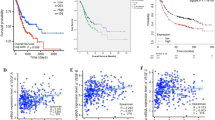Abstract
Vascular endothelial growth factor (VEGF) is up-regulated in the vast majority of human tumors. The up-regulation of VEGF not only plays important roles in tumor angiogenesis, but also provides a target for tumor treatment with small interfering RNA (siRNA) that targets VEGF; however, it is unclear whether a quite high up-regulation of VEGF will affect the efficiency of RNA interference strategies targeting VEGF. A high level expression of VEGF was found in CNE cells from a nasopharyngeal carcinoma cell line. In this study, we investigate whether VEGF-specific siRNAs can effectively suppress VEGF expression in CNE cells, and study the methods for the use of VEGF-specific siRNAs as potential therapeutic agents. CNE cells with high VEGF expression induced by hypoxia were transfected with VEGF-specific siRNAs. The expression of VEGF was effectively suppressed by VEGF-specific siRNAs, measured by ELISA, Western blot analysis and RT-PCR. Furthermore, experiments in nude mice bearing nasopharyngeal carcinoma xenograft were initiated 5 d after injection of CNE cells. VEGF-specific siRNAs were modified with 2′-deoxy, then injected into the tumors, and a liposome-mediated siRNA transfection system and ultrasound exposure were used to help delivery of the siRNAs. Tumor growth was reduced significantly after 3 weeks’ treatment. These studies suggest that VEGF-specific siRNAs still can effectively suppress VEGF expression even in tumor cell lines with a relatively high level of VEGF expression, such as CNE, and VEGF-specific siRNAs modified with 2′-deoxy can be used as potential agents for tumor therapy.
Similar content being viewed by others
References
Folkman J. Angiogenesis in cancer, vascular, rheumatoid and other disease. Nat Med, 1995, 1: 27–31
Zetter B R. Angiogenesis and tumor metastasis. Annu Rev Med, 1998, 49: 407–424
Ferrara N, Davis-Smyth T. The biology of vascular endothelial growth factor. Endocr Rev, 1997, 18: 4–25
Ferrara N, Gerber H P, LeCouter J. The biology of VEGF and its receptors. Nat Med, 2003, 9: 669–676
Raab-Traub N, Flynn K. The structure of the termini of the Epstein-Barr virus as a marker of clonal cellular proliferation. Cell, 1986, 47: 883–889
Pathmanathan R, Prasad U, Sadler R, et al. Clonal proliferations of cells infected with Epstein-Barr virus in preinvasive lesions related to nasopharyngeal carcinoma. N Engl J Med, 1995, 333: 693–698
Murono S, Inoue H, Tanabe T, et al. Induction of cyclooxygenase-2 by Epstein-Barr virus latent membrane protein 1 is involved in vascular endothelial growth factor production in nasopharyngeal carcinoma cells. Proc Natl Acad Sci USA, 2001, 98: 6905–6910
Lieberman J, Song E, Lee S K, et al. Interfering with disease: opportunities and roadblocks to harnessing RNA interference. Trends Mol Med, 2003, 9: 397–403
Mello CC, Conte D Jr. Revealing the world of RNA interference. Nature, 2004, 431: 338–342
Elbashir S M, Harborth J, Lendeckel W, et al. Duplexes of 21-nucleotide RNAs mediate interference in cultured mammalian cells. Nature, 2001, 411: 494–498
Reynolds A, Leake D, Boese Q, et al. Rational siRNA design for RNA interference. Nat Biotechnol, 2004, 22: 326–330
Takei Y, Kadomatsu K, Yuzawa Y, et al. A small interfering RNA targeting vascular endothelial growth factor as cancer therapeutics. Cancer Res, 2004, 64: 3365–3370
Burfeind P, Chernicky C L, Rininsland F, et al. Antisense RNA to the type I insulin-like growth factor receptor suppresses tumor growth and prevents invasion by rat prostate cancer cells in vivo. Proc Natl Acad Sci USA, 1996, 93: 7263–7268
Hui E P, Chan A T, Pezzella F, et al. Coexpression of hypoxia-inducible factors 1alpha and 2alpha, carbonic anhydrase IX, and vascular endothelial growth factor in nasopharyngeal carcinoma and relationship to survival. Clin Cancer Res, 2002, 8: 2595–2604
Verma I M, Somia N. Gene therapy: promises, problems and prospects. Nature 1997, 389: 239–242
Niidome T, Huang L. Gene therapy progress and prospects: nonviral vectors. Gene Therapy, 2002, 9: 1647–1652
Li S, Huang L. Nonviral gene therapy: promises and challenges. Gene Therapy, 2000, 7: 31–34
Tachibana K, Uchida T, Ogawa K, et al. Induction of cell-membrane porosity by ultrasound. Lancet, 1999, 353: 1409–1411
Gambihler S, Delius M, Ellwart J W. Permeabilization of the plasma membrane of L1210 mouse leukemia cells using lithotripter shock waves. J Membr Biol, 1994, 141: 267–275
Lawrie A, Brisken A F, Francis S E, et al. Ultrasound enhances reporter gene expression after transfection of vascular cells in vitro. Circulation, 1999, 99: 2617–2620
Bekeredjian R, Chen S, Frenkel P A, et al. Ultrasound-targeted microbubble destruction can repeatedly direct highly specific plasmid expression to the heart. Circulation, 2003, 108: 1022–1026
Chiu Y L, Rana T M. SiRNA function in RNAi: A chemical modification analysis. RNA, 2003, 9: 1034–1048
Hall A H S, Wan J, Shaughnessy E E, et al. RNA interference using boranophosphate siRNAs: Structure-activity relationships. Nucleic Acids Res, 2004, 32: 5991–6000
Braasch D, Jensen S, Liu Y, et al. RNA interference in mammalian cells by chemically-modified RNA. Biochemistry, 2003, 42: 7967–7975
Layzer J M, Mccaffrey A P, Tanner A K, et al. In vivo activity of nucleaseresistant siRNAs. RNA, 2004, 10: 766–771
Amarzguioui M, Holen T, Babaie E, et al. Tolerance for mutations and chemical modifications in a siRNA. Nucleic Acids Res, 2003, 31: 589–595
Czauderna F, Fechtner M, Dames S. Structural variations and stabilizing modifications of synthetic siRNAs in mammalian cells. Nucleic Acids Res, 2003, 31: 2705–2716
Author information
Authors and Affiliations
Corresponding authors
Additional information
Supported by Natural Science Foundation of Guangdong Province, China (Grant No. 012402)
Rights and permissions
About this article
Cite this article
Chen, S., Gao, G., Chen, W. et al. VEGF-specific siRNAs modified with 2′-deoxy effectively suppress VEGF expression and inhibit growth of nasopharyngeal carcinoma xenograft in a mouse model. Sci. China Ser. C-Life Sci. 51, 104–110 (2008). https://doi.org/10.1007/s11427-008-0020-1
Received:
Accepted:
Issue Date:
DOI: https://doi.org/10.1007/s11427-008-0020-1




